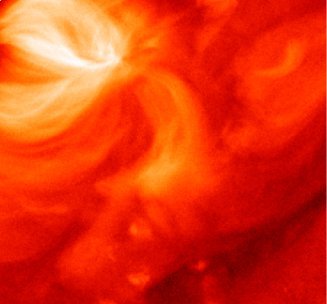An analysis of observations from the Hinode satellite suggest that the solar wind generated by the sun is probably driven by a process involving powerful magnetic fields, according to researchers at University College London and their colleagues.
The study carried out by the UCL Mullard Space Science Laboratory, Observatoire de Paris, Konkoly Observatory in Hungary and Instituto de Astronomía y Física del Espacio in Argentina, could have implications for our understanding of our nearest star and its effects on Earth and our electronic systems including communications satellites and even devices on the ground.
Scientists have long speculated as to what gives rise to the solar wind, a constant stream of extremely high energy particles that pours out from the sun in all directions. The Extreme Ultraviolet Imaging Spectrometer (EIS), on board the Japanese-UK-US Hinode satellite has produced unprecedented data that is now enabling scientists to reveal the underlying forces that give rise to the solar wind. Data provided by the SOHO/MDI consortium, international collaboration between ESA and NASA suggest that a process referred to as “slipping reconnection” may drive the solar wind.
UCL’s Deb Baker explains: “Solar wind is an outflow of million-degree gas and magnetic field that engulfs the Earth and other planets. It fills the entire solar system and links with the magnetic fields of the Earth and other planets. Changes in the Sun’s million-mile-per-hour wind can induce disturbances within near-Earth space and our upper atmosphere and yet we still don’t know what drives these outflows.

“However, our latest study suggests that it is the release of energy stored in solar magnetic fields which provides the additional driver for the solar wind. This magnetic energy release is most efficient in the brightest regions of activity on the Sun’s surface, called active regions or sunspot groups, which are strong concentrations of magnetic field. We believe that this fundamental process happens everywhere on the Sun on virtually all scales.”
The team studied images taken in February 2007 from the EIS instrument, which show hot plasma outflows. At the edges of active regions where slipping reconnection might occur, according to computer models, the researchers explain that a slow, continuous restructuring of the magnetic field leads to the release of energy and acceleration of particles in the Sun’s hot outer atmosphere, its corona.
The locations proposed by the computer model correlated with gas moving outward at up to 160,000 kilometres per hour, a thousand times faster than a terrestrial hurricane.